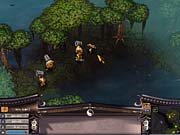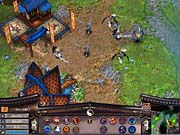Battle Realms Designer Diary #8
Ed Del Castillo talks about what it takes for a developer to get its game ready for E3.
Entry #8 - 05/29/01
By Ed Del Castillo
President, Liquid Entertainment
Spring is here again already, and as May rolls around, we're almost ready for another E3. By the time you read this, E3 will have come and gone, but at the moment, we're still putting the finishing touches on our demo. Everyone at Liquid is scrambling to make Battle Realms the best it can be and create a demo that will show off the game's great potential.
Coincidentally, May also marks our beta milestone. One of the challenges we've faced is that the demands of E3 and the demands of our beta milestone were very different. The milestone requires that we get a rough draft of everything into the game--every last asset, level, and feature--even if the asset isn't finalized. E3, on the other hand, requires that a small part of the game be as polished as we can make it, so that it most represents what the end product will look like.
So what's it like preparing for a trade show? Well, it's a ton of work, a mountain of stress, and a world of pain. It's a nightmare--but when buyers get their first look at the game, and their eyes light up because they "get it," then the nightmare has a happy ending.
What does a good trade show demo look like? If it's not the final game itself, it's got to clearly demonstrate all the best features that the final game will have. It's got to be flashy to draw attention on a crowded show floor. It's got to be polished, so it doesn't crash in the middle of a demonstration. It should be free of graphical glitches and other obvious visual bugs.
But an E3 demo can't, and shouldn't, show off every last feature of the game. Trade show pitches need to be kept short; it's more important that 100 people see your game for a few minutes each than 10 people spend half an hour with it. If the demo bogs down in details, you've lost your audience.
For Battle Realms, we knew we were going to have six stations, in two groups of three stations each. We wanted to show off multiplayer, so we decided to devote one of the three stations in each group to constant multiplayer games between Liquid employees. Another station would be set up for skirmish games against the AI, while the final and most important station would be used to walk through a specially designed demo map. The skirmish stations could be used as backup demo stations if the primary stations got too busy.
Our excellent map editor allowed us to put together the demo map in a couple of days. We didn't want to show off Battle Realms by playing a complete skirmish or multiplayer game on the demo map; that's what would be happening at the other stations. Instead, we packed as many of the unique features of Battle Realms on one map as we possibly could--fire, watchtowers, height advantage, rolling boulders, our unique training system, the coolest units from several clans, and more. The goal was to show off Battle Realms at its best, and while we included standard RTS features such as resource collection and building on the map, we didn't want those features to become the focus of our demo.
On the Floor
Locking down a demo version of the game is the easy part; the real mayhem begins when it's time to set things up at the booth. Because the game still isn't finished, a lot of compatibility testing hasn't been done yet. Eventually, the testers will put the title through its paces and we'll iron out all the video card glitches and sound problems, but until the test cycle is well underway, an unfinished PC game typically needs a very specific set of hardware to run optimally.
Setting up the systems on the floor and making sure everything works right requires extraordinary attention to detail. Most of the hardware on the floor will be rented, and rented systems can be flaky. One untested interaction--a video card we haven't tried, an unusual configuration, or any combination of hardware that doesn't match exactly what we use for day-to-day development--and the game might not run on the floor. Everything has to be triple-checked or the show could easily become a disaster, and often, we aren't able to get our hands on the rental systems until a day or two before the show.
The big day finally comes--the first day of the show. We'll run through our demo for hundreds of people as everyone scurries from booth to booth looking for the "next big thing." If we're lucky, we'll get five minutes with each person. If the game is showing really well, we might only get 30 seconds. If we've got a hit on our hands, the second day could be even busier as word of mouth spreads.
By the third day, things will have quieted down. It's then that the game's biggest fans will come back for hands-on time with the game. For people who want to get a closer look at a game's features, or buyers who want to talk in depth with a team member, the last day of the show is even more important than the first. We'll have time to delve into the kind of detailed information that the hard-core gamer is interested in: What are the "killer units" for the Dragon clan? What are the coolest multiplayer strategies? And how the heck do you beat the Lotus clan's master warlock?
Will Battle Realms be a hit at E3? We'll have to wait a couple of weeks to find out. A good E3 reception for a product can make a game a hit, but a bad showing can doom a title to early retirement in the bargain bin. We're sure we've got something special, but it's time to see what our audience thinks.
Got a news tip or want to contact us directly? Email news@gamespot.com


Join the conversation